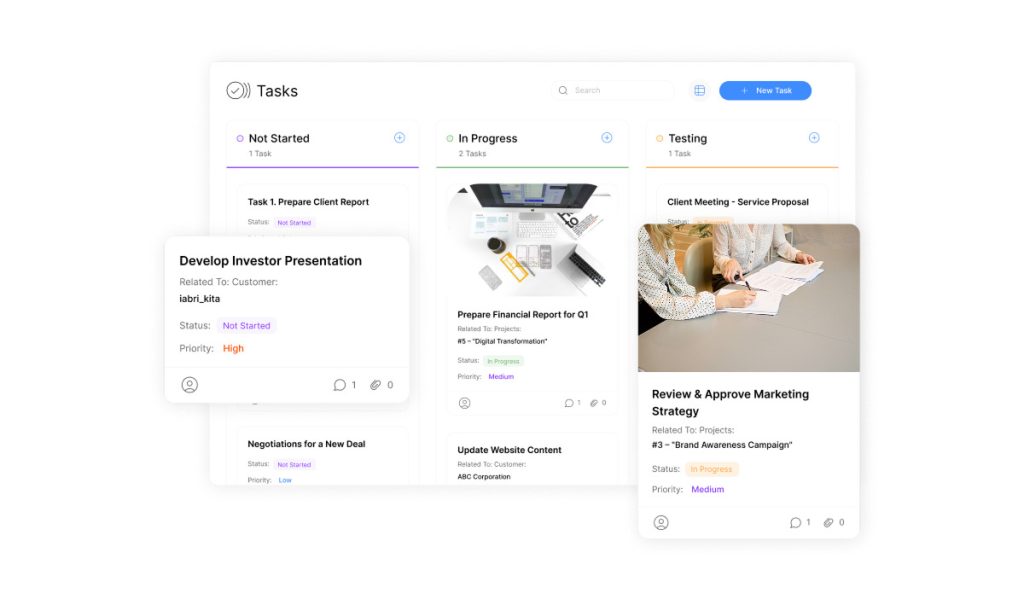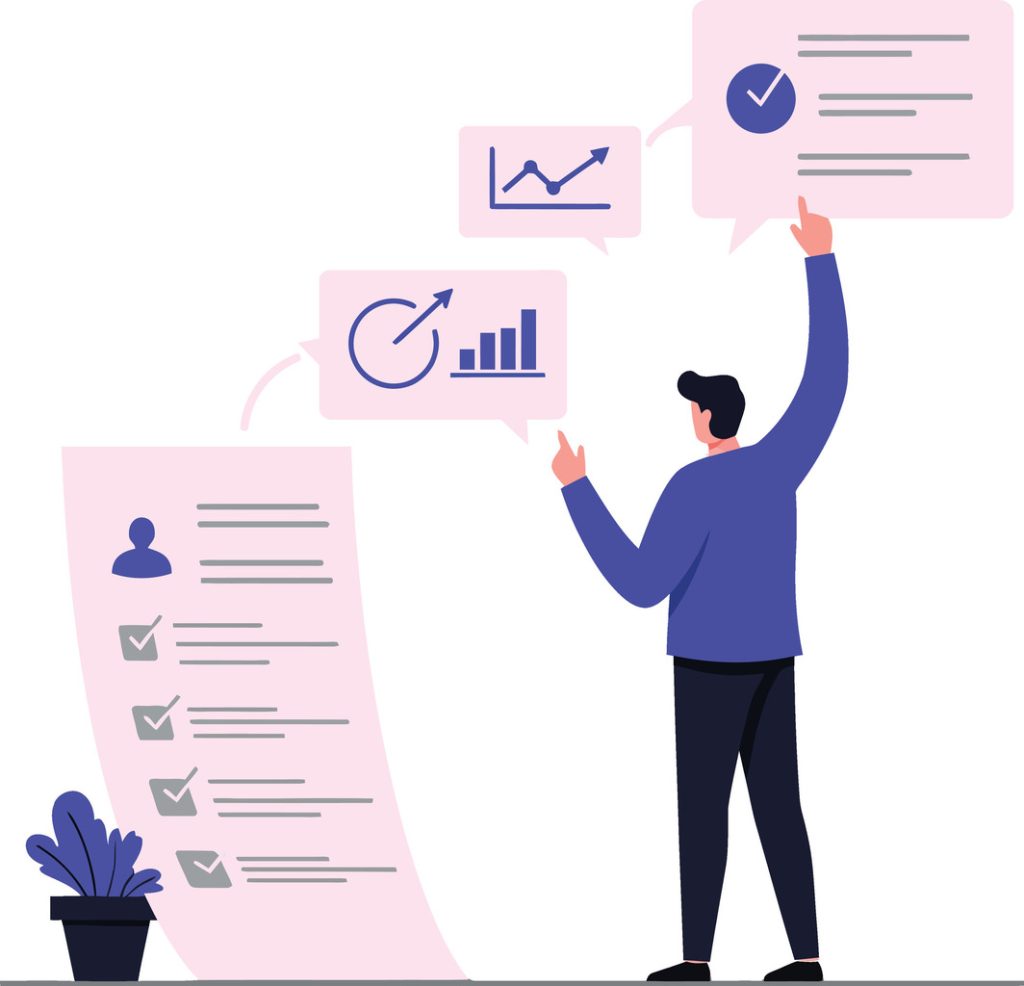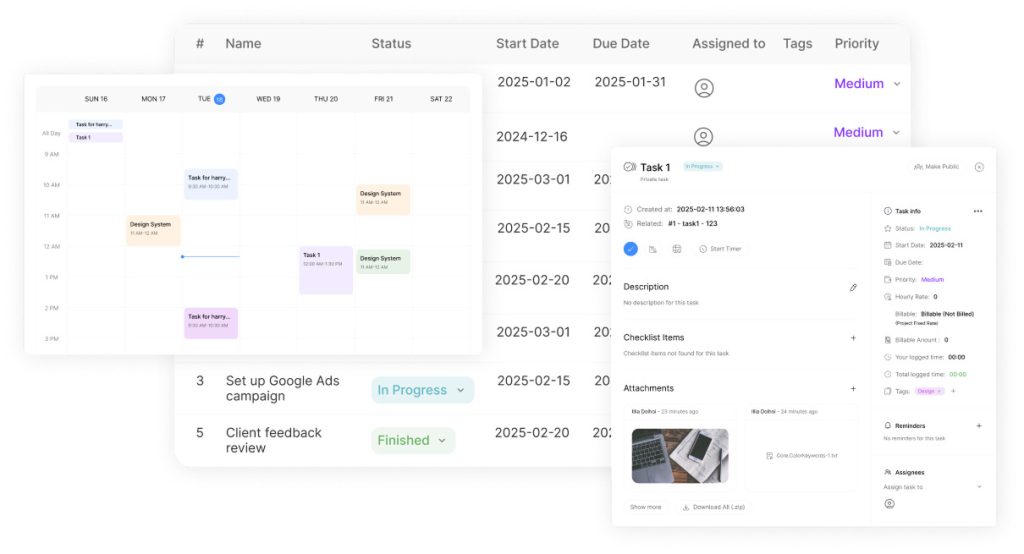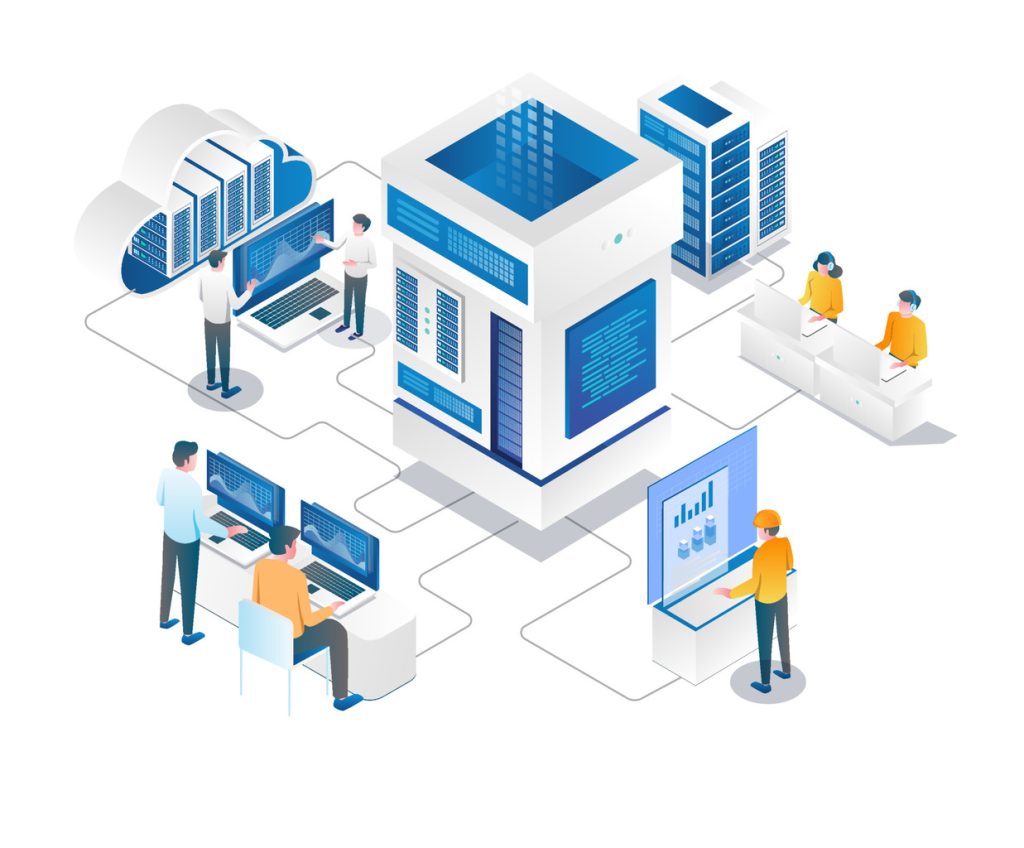Lead and Customer Tasks to Streamline Operations

Effective task management is crucial for businesses aiming to enhance their customer service and streamline operations. By assigning tasks with clear deadlines and reminders tied to specific customers, organizations can significantly improve their customer relationship processes.
Businesses can track follow-ups, deadlines, and key touchpoints throughout the customer journey by implementing a structured task management system. This approach not only reduces the risk of missed opportunities but also enhances customer satisfaction. Utilizing a comprehensive platform like ClearCRM can further streamline engagement and accelerate sales growth, bringing all interactions to one place.
Key Takeaways
- Effective task management is essential for enhancing customer service and operational efficiency.
- Assigning tasks with deadlines and reminders improves customer relationship processes.
- Structured task management systems reduce the risk of missed opportunities.
- ClearCRM offers a unified business platform to centralize operations and enhance customer experiences.
- Implementing task management solutions can significantly boost business success.
Understanding the Importance of Lead/Customer Tasks

Effective task management is crucial for businesses aiming to enhance customer satisfaction and drive long-term success. In the context of customer relationship management, tasks are the backbone that supports the entire customer journey, from initial lead qualification to post-purchase support and retention efforts.
Task management serves as the foundation for effective customer relationship management, creating a structured approach to handling customer interactions and follow-ups. By implementing a comprehensive task management strategy, businesses can track the customer journey from end to end, identifying potential bottlenecks or areas for improvement. This proactive approach enables organizations to respond timely to customer inquiries, solve problems proactively, and follow through on commitments consistently.
The Role of Task Management in Customer Success
Task management directly impacts customer success by ensuring that critical customer touchpoints are never missed. Organizations with robust task management systems typically see higher customer satisfaction rates, improved team productivity, and more predictable business outcomes. By creating accountability within teams, task management clearly defines who is responsible for each customer interaction and establishes clear expectations for task completion.
| Benefits of Task Management | Impact on Customer Success |
|---|---|
| Structured Approach to Customer Interactions | Improved Customer Satisfaction |
| Timely Responses to Inquiries | Enhanced Customer Experience |
| Proactive Problem-Solving | Increased Customer Loyalty |
| Clear Accountability within Teams | Better Team Productivity |
As emphasized by industry experts, “Customer success is not just about support—it’s about proactively helping customers achieve their desired outcomes.” Effective task management is key to achieving this goal, enabling businesses to deliver exceptional customer service and build strong, lasting relationships.
By prioritizing task management, businesses can drive customer retention and growth, ultimately contributing to the company’s revenue and long-term success. With a well-organized task system in place, companies can ensure that every customer interaction is handled professionally and efficiently, leading to improved customer satisfaction and loyalty.
The Fundamentals of Lead/Customer Tasks

To deliver exceptional customer experiences, businesses must understand the fundamentals of lead and customer tasks. These tasks are the building blocks of a successful customer relationship management strategy, enabling companies to engage with customers proactively and consistently throughout their lifecycle.
Defining Lead/Customer Tasks
Lead/customer tasks are structured activities assigned to team members that relate directly to prospect or customer interactions, with specific objectives and timeframes for completion. These tasks are designed to be specific, measurable, achievable, relevant, and time-bound (SMART), maximizing effectiveness and team adoption. By leveraging CRM software like Salesforce, Zendesk, or HubSpot, businesses can track customer interactions, manage cases, and automate workflows efficiently.
Types of Tasks in Customer Relationship Management
Different types of tasks serve various purposes in the customer journey, from prospecting and lead nurturing to onboarding, support issue resolution, and retention activities. Effective task management systems incorporate clear ownership, specific deadlines, priority levels, and automated reminders to ensure nothing falls through the cracks. Some key task types include:
- Lead nurturing tasks to engage potential customers
- Onboarding tasks to ensure a smooth customer onboarding process
- Support tasks to resolve customer issues promptly
- Retention tasks to maintain strong customer relationships
Key Components of Effective Task Management
Effective task management is crucial for delivering exceptional customer experiences. Key components include task creation templates, assignment protocols, deadline setting guidelines, and reminder systems that balance urgency with productivity. By integrating these components seamlessly with existing CRM systems, businesses can create a single source of truth for all customer-related activities, enhancing overall customer service. Moreover, effective task management also involves educating team members on how to manage email tasks efficiently, ensuring that no communications fall through the cracks. Training sessions can be organized to showcase best practices for prioritizing emails and responding promptly. This proactive approach not only streamlines workflow but also fosters stronger relationships with customers, ultimately leading to increased satisfaction and loyalty.
By understanding and implementing these fundamentals, businesses can significantly improve their customer relationship management capabilities, leading to enhanced customer satisfaction and loyalty.
Setting Up a Task Management System for Customer Success

To deliver exceptional customer experiences, businesses must establish a robust task management system. This system serves as the foundation for organizing and managing tasks related to leads and customers, ensuring that customer success teams can operate efficiently.
Defining Your Task Management Goals
Establishing a task management system begins with clearly defining your objectives. Whether the focus is on improving response times, increasing customer satisfaction, or enhancing team productivity, having clear goals is essential. The Customer Success Team Lead must balance the needs of customers with the goals of the organization, making it crucial to define task management goals that align with both.
Goals should follow the SMART framework: specific, measurable, achievable, relevant, and time-bound. For instance, a goal might be to reduce the average response time to customer inquiries by 30% within the next quarter. By setting such goals, teams can focus their efforts on high-impact activities.
Choosing the Right Task Management Approach
Successful implementation of a task management system requires selecting the right approach that aligns with your team structure, customer base, and existing technological infrastructure. The chosen approach should facilitate seamless integration with your customer journey mapping, ensuring that tasks are created at the right moments and assigned to the appropriate team members based on customer needs and behaviors.
Consider both the technical aspects, such as software selection and integration capabilities, and the human factors, including team adoption, training requirements, and change management. The most effective task management systems are those that mirror the customer journey, with specific task types and templates for each stage from lead acquisition to retention.
Integrating Tasks with Your Customer Journey
The most effective task management systems are designed to mirror the customer journey. This involves creating specific task types and templates for each stage of the customer journey, from lead acquisition to retention. By integrating tasks with the customer journey, businesses can ensure that tasks are created and assigned based on customer needs and behaviors, enhancing the overall customer experience.
To achieve this integration, it’s essential to map out the customer journey and identify key touchpoints where tasks can be created and assigned. This not only improves the efficiency of the task management system but also ensures that customer interactions are timely and relevant.
By following these steps and continuously refining the task management system based on team input and customer outcomes, businesses can create a robust framework for achieving customer success. The key is to remain focused on the customer journey and to use task management as a tool to enhance the customer experience.
Creating Effective Customer-Related Tasks
Businesses that prioritize customer-related tasks are better positioned to deliver exceptional customer experiences. As a Customer Success Team Lead, overseeing a team of Customer Success Managers and driving customer retention and growth are critical responsibilities.
Task Creation Best Practices
Effective customer-related tasks start with a clear purpose and expected outcome. To ensure team members understand exactly what needs to be accomplished and why it matters, task creation should follow a standardized format. This includes all necessary information while remaining concise and actionable for quick comprehension and execution.
- Define the task’s objective and its relevance to customer success.
- Identify the resources required to complete the task.
- Establish clear success criteria for task completion.
Writing Clear and Actionable Task Descriptions
Well-crafted task descriptions are essential for ensuring that team members understand their responsibilities. These descriptions should include specific actions required, relevant customer context, necessary resources or references, and clear success criteria.
For instance, rather than assigning a vague task like “Follow up with customer,” use a more actionable task description such as “Schedule a call with Customer X to discuss their concerns about our product, referencing their previous support tickets and providing a solution based on our latest update.”
Prioritizing Tasks for Maximum Impact
Prioritization frameworks help teams focus on high-impact activities first. This typically involves balancing factors like customer value, urgency, effort required, and strategic importance. Implementing a consistent task categorization system, such as urgent/important matrices or numerical priority levels, helps teams quickly identify which tasks demand immediate attention.
| Task Priority | Customer Value | Urgency | Effort Required |
|---|---|---|---|
| High | High | High | Medium |
| Medium | Medium | Low | Low |
| Low | Low | Low | High |
By prioritizing tasks effectively, businesses can maximize their impact on customer satisfaction and retention. Regular review of task effectiveness also helps refine the approach over time, eliminating unnecessary tasks and enhancing those that drive meaningful customer results.
Assigning Tasks to Team Members

Effective task assignment is crucial for maximizing team efficiency in customer service operations. A Customer Service Team Lead plays a vital role in ensuring that tasks are distributed appropriately among team members, aligning with the organization’s customer service standards.
Task Assignment Strategies
Strategic task assignment considers various factors, including team member expertise, workload balance, customer history, and task complexity. By adopting effective assignment strategies, businesses can ensure that the right people handle the right customer interactions at the right time.
- Consider team member skills and strengths when assigning tasks.
- Balance workload across the team to prevent burnout and optimize productivity.
- Take into account customer history and preferences when assigning tasks.
Matching Tasks to Team Member Skills and Roles
Matching tasks to team member skills and roles is essential for creating better outcomes for both customers and employees. Specialists should handle complex issues, while generalists manage routine inquiries. This approach not only enhances customer satisfaction but also fosters skill development among team members.
| Task Type | Team Member Skill/Role | Customer Benefit |
|---|---|---|
| Complex Issue Resolution | Specialized Skills | Personalized Support |
| Routine Inquiries | General Customer Service Skills | Quick Response Times |
Ensuring Accountability in Task Assignments
To ensure tasks are completed according to standards and deadlines, businesses must implement accountability systems. This includes clear ownership, progress tracking, and regular check-ins. By doing so, organizations can maintain high levels of customer satisfaction and team productivity.
In conclusion, assigning tasks to team members requires a thoughtful and strategic approach. By considering team member skills, workload balance, and customer needs, businesses can maximize team efficiency and enhance customer experience.
Setting Effective Deadlines for Customer Tasks

Setting the right deadlines for customer tasks is a delicate balance between urgency and realism. Customer success teams must navigate the complexities of deadline setting to ensure timely task completion while maintaining high-quality service. Effective deadline setting is crucial for managing customer expectations and ensuring that tasks are completed on time.
The Psychology of Deadlines
Understanding the psychological impact of deadlines is vital for customer success teams. Deadlines can motivate team members to complete tasks promptly, but unrealistic deadlines can lead to undue stress and decreased productivity. By understanding how deadlines affect team morale and work quality, managers can create timelines that drive productivity while maintaining a positive work environment.
The psychological impact of deadlines can be significant. Team members may feel a sense of accomplishment when meeting deadlines, which can boost morale and motivation. Conversely, consistently missing deadlines can lead to frustration and decreased job satisfaction. By setting realistic deadlines and providing the necessary resources, teams can achieve a better work-life balance and improve overall job satisfaction.
Determining Realistic Timeframes
Determining realistic timeframes is critical for effective deadline setting. This involves considering task complexity, available resources, team capacity, and customer expectations. By analyzing these factors, teams can create realistic timelines that balance urgency with achievability.
To determine realistic timeframes, teams should assess the task requirements, identify potential roadblocks, and allocate sufficient time for completion. This may involve breaking down complex tasks into smaller, manageable chunks, and establishing milestones to track progress.
- Assess task complexity and requirements
- Identify available resources and potential roadblocks
- Allocate sufficient time for task completion
- Establish milestones to track progress
Deadline Setting Best Practices
Effective deadline setting involves several best practices that can help teams achieve their goals. These include building in buffer time for unexpected complications, considering dependencies between tasks, and aligning deadlines with customer-facing commitments.
By consistently communicating the reasoning behind deadlines to team members, managers can help them understand the importance of timely completion and its impact on customer experience. Regular analysis of actual completion times versus estimated timeframes can also help refine the deadline setting approach over time, creating more accurate and effective timelines.
Some key deadline setting best practices include:
- Building in buffer time for unexpected complications
- Considering dependencies between tasks
- Aligning deadlines with customer-facing commitments
- Communicating the reasoning behind deadlines to team members
- Regularly analyzing actual completion times versus estimated timeframes
Implementing Reminder Systems for Task Completion
Implementing an effective reminder system is crucial for ensuring task completion in customer service management. A reminder system helps prevent tasks from being forgotten or delayed, ensuring consistent follow-through on customer commitments and internal processes. By leveraging technology and strategic planning, businesses can create a reminder system that enhances productivity and improves customer satisfaction.
Reminder Types for Various Task Categories
Different task categories require tailored reminder approaches. For instance, urgent customer issues necessitate frequent, escalating reminders, while routine tasks benefit from standard interval notifications. By categorizing tasks based on their urgency and importance, businesses can develop a reminder strategy that addresses the unique needs of each task category.
- Urgent tasks: Frequent reminders with increasing urgency as deadlines approach
- High-priority tasks: Regular reminders with clear consequences for missed deadlines
- Routine tasks: Standard interval notifications to maintain consistency
Crafting an Optimal Reminder Cadence
Creating an effective reminder cadence involves determining the right frequency, timing, and communication channels for notifications based on task priority and team workflows. Businesses must balance the need for timely reminders with the risk of notification fatigue. By analyzing task data and team feedback, companies can develop a reminder cadence that optimizes task completion without overwhelming team members.
| Task Priority | Reminder Frequency | Communication Channel |
|---|---|---|
| High | Daily | Email and SMS |
| Medium | Weekly | |
| Low | Bi-Weekly | In-app notification |
Balancing Reminders and Productivity
A well-designed reminder system must balance the need for task completion with respect for team member focus and productivity. To achieve this balance, businesses can implement automated reminders through CRM systems or task management platforms, reducing the administrative burden of manual follow-ups. Additionally, combining system notifications with human oversight allows managers to identify patterns of delayed tasks and address underlying causes, further enhancing productivity.
By implementing a strategic reminder system, businesses can improve task completion rates, enhance customer satisfaction, and increase overall productivity. As companies continue to refine their reminder systems, they can reap significant benefits in terms of efficiency and customer loyalty.
Essential Tools for Managing Lead/Customer Tasks

In today’s fast-paced business environment, having the right tools for managing lead and customer tasks is vital. Effective customer task management enables businesses to deliver exceptional service, build strong relationships, and drive growth. To achieve this, companies utilize various tools and technologies that streamline task management processes.
CRM Systems with Task Management Features

Modern CRM systems offer robust task management capabilities that integrate customer data with action items, creating a unified platform for relationship management and task execution. Leading CRM solutions like Salesforce, HubSpot, and Zoho CRM provide customizable task creation, assignment, deadline setting, and reminder features specifically designed for customer-facing teams.
Dedicated Task Management Platforms
Dedicated task management platforms such as Asana, Monday.com, and ClickUp offer more sophisticated task organization, visualization, and collaboration features that can complement CRM systems. These platforms enable teams to manage complex tasks and projects more efficiently, ensuring that customer tasks are completed on time and to a high standard.
Mobile Apps for On-the-Go Task Management
Mobile applications enable on-the-go task management, allowing team members to create, update, and complete customer tasks from anywhere. This is particularly valuable for field sales and service teams who need to access and manage tasks remotely. By leveraging mobile task management apps, businesses can enhance productivity and responsiveness to customer needs.
When selecting tools for managing lead and customer tasks, businesses should consider factors such as user experience, customization options, reporting capabilities, integration potential, and scalability. By choosing the right tools and technologies, companies can streamline their task management processes, improve customer satisfaction, and drive business success.
Integrating Tasks with Your CRM System
The integration of tasks within a CRM system offers a unified platform for managing customer interactions and related action items. This integration is crucial for businesses aiming to enhance their customer service and improve operational efficiency. By leveraging CRM automation, companies can streamline their workflows and provide more personalized customer experiences.
Advantages of Combining Task Management with CRM
Integrating task management with your CRM system brings numerous benefits, including improved efficiency and enhanced customer satisfaction. Some key advantages include:
- Unified platform for customer information and action items, eliminating silos and improving efficiency.
- Context-rich task management, allowing team members to access relevant customer history and preferences.
- Enhanced collaboration among team members, ensuring everyone is on the same page regarding customer interactions.
By integrating tasks with your CRM, you can create a seamless customer service experience. This integration enables your team to access all relevant customer data in one place, making it easier to manage customer relationships effectively. Additionally, utilizing CRM software for sales efficiency allows your team to track interactions and analyze performance metrics, providing valuable insights for future strategies. With this comprehensive visibility, you can personalize communication and anticipate customer needs, fostering stronger relationships. Ultimately, this leads to improved customer satisfaction and increased loyalty, driving long-term success for your business.
Steps for Implementing CRM-Task Integration
To successfully integrate tasks with your CRM system, follow these implementation steps:
- Map your current workflows to identify areas where integration can improve efficiency.
- Define your integration requirements, including the types of tasks and customer data to be integrated.
- Configure the system connections, ensuring seamless data flow between your CRM and task management tools.
- Train your team members on the new processes and tools to ensure a smooth transition.
Effective implementation requires careful planning and a phased approach, starting with basic functionality and gradually adding more features as your team adapts to the new system.
Evaluating the Success of Your Integration
To measure the success of your CRM-task integration, track key metrics such as task completion rates, time savings, and improvements in data accuracy. Ultimately, the goal is to enhance customer satisfaction and retention. Regularly reviewing these metrics will help you identify areas for further improvement and ensure that your integration is meeting its intended objectives.
By following these guidelines and leveraging the right tools, businesses can achieve a successful CRM-task integration that drives long-term success.
Automating Lead/Customer Tasks for Efficiency

Automating lead and customer tasks is crucial for businesses aiming to enhance efficiency and streamline operations. By leveraging automation, companies can handle routine and repetitive tasks without human intervention, freeing up their teams to focus on high-value customer interactions.
Identifying Tasks for Automation
To effectively automate tasks, businesses must first identify the tasks that are ideal for automation. These include task creation based on triggers, such as new lead acquisition or support ticket submission, routine follow-up reminders, status update notifications, and data entry tasks. By automating these tasks, businesses can reduce the workload on their teams and minimize the risk of human error. Additionally, businesses can further optimize their workflows through task automation for deal stages, ensuring that critical processes align seamlessly with the sales cycle. This allows for timely interventions and improvements in conversion rates, as team members can focus more on strategic initiatives rather than repetitive tasks. Moreover, integrating automation tools can facilitate better communication among departments, enhancing collaboration and overall efficiency.
For instance, a customer service platform that supports automation, like Gorgias with its Automation Add-on, can deflect up to a third of repetitive, tedious tickets instantly, with no human interaction. This not only improves efficiency but also enhances the customer experience by providing timely responses.
Setting Up Task Automation Workflows
Setting up effective automation workflows requires a systematic approach. Businesses need to identify repetitive processes, map the logical flow of actions and decisions, configure triggers and conditions, and establish clear outcomes. Modern CRM and task management systems offer no-code or low-code automation builders that allow teams to create sophisticated workflows without extensive technical knowledge.
When setting up automation workflows, it’s essential to consider the customer journey and ensure that the automation aligns with the overall customer service strategy. This includes configuring triggers that are relevant to the customer’s interactions and ensuring that the automated tasks are completed within the desired timeframe.
Maintaining a Balance Between Automation and Personal Touch
While automation can significantly enhance efficiency, it’s crucial to maintain a balance between automation and personal touch. The most successful automation strategies use technology to handle routine elements while preserving human touch for meaningful customer moments. This involves implementing guardrails in automation to identify exceptions or complex cases that require human intervention, ensuring that customers never feel trapped in an impersonal system.
Regular review of automation performance is also vital to refine workflows over time, identifying opportunities for improvement or areas where human involvement may need to be reintroduced. By striking the right balance between automation and personal touch, businesses can create a customer service experience that is both efficient and personalized.
Team Structure for Effective Task Management
For customer success teams to manage tasks effectively, they need a clear and defined structure. A well-organized team is essential for delivering exceptional customer service and ensuring that tasks are completed efficiently. The team structure should be designed to facilitate collaboration, accountability, and clear communication.
Roles and Responsibilities in Task Management
A customer success team typically consists of various roles, each with distinct responsibilities. These roles include Customer Success Managers (CSMs) who manage customer relationships, Onboarding Specialists who ensure seamless onboarding experiences, Technical Support Representatives who provide technical assistance, and Customer Success Operations Analysts who analyze data and optimize processes.
| Role | Responsibilities |
|---|---|
| Customer Success Managers (CSMs) | Managing customer relationships, handling escalations, conducting quarterly business reviews |
| Onboarding Specialists | Ensuring seamless onboarding experiences for new customers |
| Technical Support Representatives | Providing technical assistance to customers via multiple channels |
| Customer Success Operations Analysts | Analyzing data, reporting, and process optimization |
Training Team Members on Task Protocols
Comprehensive training on task protocols is crucial for consistent implementation across the team. This training should cover task creation standards, priority determination, deadline setting, and proper documentation. Ongoing training and regular refreshers are necessary to adapt to changing processes and to onboard new team members.
Key aspects of task protocol training include:
- Task creation standards
- Priority determination
- Deadline setting
- Proper documentation
Fostering Collaboration Around Customer Tasks
Collaborative approaches to customer tasks leverage diverse perspectives and skill sets, which is particularly valuable for complex customer situations. Creating a culture of shared responsibility for customer outcomes encourages proactive collaboration and knowledge sharing across the team. Implementing collaboration tools and regular cross-functional meetings ensures that all team members have visibility into customer-related tasks and can contribute their expertise when needed.
By structuring the team effectively, providing comprehensive training, and fostering collaboration, customer success teams can manage tasks more efficiently and deliver exceptional customer service.
Measuring Task Performance and Success
To gauge the success of customer-related tasks, businesses must implement effective performance measurement strategies. Measuring task performance provides critical insights into team efficiency, process effectiveness, and ultimately, the impact on customer outcomes and business results.
Key Metrics for Task Management
Key performance indicators for task management typically include completion rates, on-time percentage, average time to completion, task quality scores, and the correlation between task execution and customer satisfaction metrics. As a Customer Service Team Lead, performance is measured by KPIs such as customer retention rate, Net Promoter Score (NPS), Customer Lifetime Value (CLV), churn rate, and upsell and cross-sell success rates.
| KPI | Description |
|---|---|
| Customer Retention Rate | Monitors the percentage of customers retained over a specific period. |
| Net Promoter Score (NPS) | Tracks customer satisfaction through regular NPS surveys. |
| Customer Lifetime Value (CLV) | Calculates the total value of each customer to the business. |
| Churn Rate | Monitors the percentage of customers who cancel their subscriptions or services. |
| Upsell/Cross-sell Success Rates | Tracks the success of efforts to sell additional products or services to existing customers. |
Creating Dashboards for Task Visibility
Visual dashboards create at-a-glance visibility into task status and performance, helping managers identify bottlenecks, at-risk deadlines, and team capacity issues before they impact customers. Effective dashboards combine team-level metrics for management oversight with individual-level data that helps team members track their own performance and workload.
Using Task Data for Process Improvement
Task data analysis reveals patterns and trends that can inform process improvements, such as identifying commonly delayed task types, peak workload periods, or inefficient workflows. Regular performance reviews should examine both quantitative metrics and qualitative factors, including customer feedback on task outcomes and team member input on process challenges.
The most valuable task measurement approaches connect operational metrics to customer experience indicators, demonstrating how task execution directly influences customer satisfaction and loyalty. By leveraging these insights, businesses can refine their task management strategies to enhance customer service and drive overall success.
Common Challenges in Lead/Customer Task Management

Customer Success Teams often encounter numerous challenges in managing lead and customer tasks. As a Customer Success Team Lead, you’ll face various obstacles that can impact your team’s performance and customer satisfaction. Common challenges include scaling customer success operations while maintaining personalized service as the customer base grows, and aligning customer success with other departments to ensure seamless collaboration with sales, product, and marketing teams.
Task Overload and Prioritization Issues
Task management systems often face challenges that can undermine their effectiveness, including task overload that overwhelms team members and creates backlogs of customer-related activities. Prioritization difficulties arise when teams lack clear frameworks for determining which tasks deserve immediate attention, particularly when multiple customers have competing needs or deadlines. To address these issues, teams can implement tiered priority systems and create clear escalation paths for urgent issues.
Deadline Management Challenges
Deadline management challenges include unrealistic timeframes, competing priorities, unexpected complications, and the difficulty of coordinating interdependent tasks across team members. Effective deadline management involves establishing realistic buffer times in deadlines and developing cross-training programs to distribute workload. By doing so, teams can better manage deadlines and improve overall task management.
Solutions for Common Task Management Problems
Common task management problems also include poor visibility across teams, inconsistent execution standards, inadequate tracking mechanisms, and difficulty measuring the actual impact of completed tasks. Technology solutions like workload balancing algorithms, automated priority scoring, and predictive deadline management tools can help address many common task management challenges. Regular process reviews and team feedback sessions help identify emerging challenges before they become systemic problems, allowing for proactive adjustments to task management approaches.
By understanding these challenges and implementing effective solutions, Customer Success Teams can enhance their task management capabilities, leading to improved customer service and overall business success.
Advanced Strategies for Customer-Centric Task Management
Customer-centric task management has evolved, with businesses now leveraging advanced strategies to enhance customer interactions. This evolution is driven by the need to provide more personalized, proactive, and efficient customer service. By adopting these advanced strategies, companies can significantly improve customer satisfaction and loyalty. By integrating data analytics and feedback mechanisms, businesses can gain valuable customer insights for business growth. This wealth of information allows companies to tailor their offerings and anticipate customer needs, leading to a more responsive and engaging service. Ultimately, leveraging these insights fosters a deeper relationship with customers, driving long-term success.
Predictive Task Creation Based on Customer Behavior
Predictive task creation is a game-changer in customer-centric task management. By analyzing historical data and behavioral triggers, businesses can automatically generate tasks that anticipate customer needs. For instance, renewal reminders can be triggered based on usage patterns, or proactive check-ins can be initiated when engagement metrics decline. This approach enables companies to stay ahead of customer needs, providing timely and relevant support.
Key benefits of predictive task creation include:
- Proactive customer support
- Improved customer retention
- Enhanced customer experience
Personalizing Tasks for Different Customer Segments
Personalization is crucial in today’s customer service landscape. By segmenting customers based on characteristics such as size, industry, lifecycle stage, or value tier, businesses can customize the type, frequency, and content of tasks. This ensures that customers receive relevant and timely support, improving overall satisfaction. For example, high-value customers may require more frequent check-ins, while smaller customers might need more educational content.
Effective personalization involves:
- Understanding customer segments
- Tailoring tasks to segment needs
- Continuously refining segmentation strategies
Using AI to Enhance Task Management
Artificial Intelligence (AI) is transforming task management by optimizing task routing, prioritization, and scheduling. AI algorithms can analyze customer value, issue complexity, and team member expertise to ensure that tasks are assigned efficiently. Additionally, Natural Language Processing (NLP) can analyze customer communications to automatically create and prioritize tasks based on sentiment, urgency, and content.
AI-enhanced task management offers several advantages:
- Improved task efficiency
- Enhanced customer satisfaction
- Data-driven decision making
By integrating these advanced strategies, businesses can create a more responsive, proactive, and personalized customer service environment. This not only improves customer satisfaction but also drives loyalty and long-term growth.
Case Studies: Successful Implementation of Customer Task Systems

Effective customer task management has emerged as a key factor in driving business success and customer satisfaction. Organizations across various industries have successfully implemented customer task management systems, achieving measurable results and improving their overall customer service.
Small Business Case Study
A growing e-commerce company streamlined their customer follow-up process by implementing a structured task management system. This resulted in a 65% reduction in response times and a significant increase in customer satisfaction scores. By automating routine tasks and prioritizing customer inquiries, the company was able to enhance its customer service while reducing operational costs.
Enterprise-Level Implementation
A multinational corporation integrated task management across global teams, standardizing customer service processes while maintaining regional flexibility. This enterprise-level implementation enabled the corporation to improve customer service consistency and reduce training times for new employees. The integration also facilitated better coordination among teams, leading to improved customer outcomes.
Lessons Learned from Real-World Examples
Common success factors across these case studies include executive sponsorship, clear success metrics, phased implementation approaches, comprehensive training programs, and continuous improvement mechanisms. Organizations that achieved the greatest success typically integrated their task management systems with existing customer data platforms, creating a unified view of customer interactions and activities. These case studies provide practical blueprints that can be adapted to various business contexts, offering both strategic frameworks and tactical implementation tips.
The implementation of customer task management systems has shown that with the right approach, businesses can significantly enhance customer satisfaction and operational efficiency. By learning from these real-world examples, organizations can tailor their task management strategies to meet their specific needs and achieve similar success.
Conclusion
In today’s competitive business landscape, effective customer task management is crucial for driving customer satisfaction and revenue growth. Businesses that excel in this area are better positioned to achieve their goals.
Throughout this guide, we’ve explored the fundamental components of successful task management, from creation and assignment to deadline setting and performance measurement. The integration of task management with customer relationship management creates a powerful system that ensures consistent follow-through on commitments while providing valuable data for continuous improvement.
As technology continues to evolve, organizations have unprecedented opportunities to leverage automation, AI, and predictive analytics to create more proactive and personalized task management approaches. Implementing these strategies requires commitment to change management, investment in appropriate tools, and ongoing refinement based on results and feedback.
Organizations that excel at customer task management typically develop a culture that values both efficiency and customer-centricity. The ultimate measure of success is not just task completion metrics, but the tangible impact on customer experience, team productivity, and business outcomes that result from well-executed task management.
By focusing on customer service, team support, and lead management, businesses can create a robust task management system that drives success. As companies continue to prioritize customer satisfaction, the importance and demand for effective task management will only grow.

